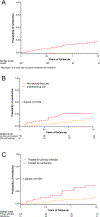Reinfection incidence and risk among people treated for recent hepatitis C virus infection
- PMID: 37467042
- PMCID: PMC10529102
- DOI: 10.1097/QAD.0000000000003651
Reinfection incidence and risk among people treated for recent hepatitis C virus infection
Abstract
Objective: Reinfection poses a challenge to hepatitis C virus (HCV) elimination. This analysis assessed incidence of, and factors associated with reinfection among people treated for recent HCV (duration of infection <12 months).
Methods: Participants treated for recent HCV (primary infection or reinfection) in an international randomized trial were followed at 3-monthly intervals for up to 2 years to assess for reinfection. Reinfection incidence was calculated using person-time of observation. Factors associated with HCV reinfection were assessed using Cox proportional hazards regression analysis.
Results: Of 222 participants treated for recent HCV, 196 (62% primary infection, 38% reinfection) were included in the cohort at risk for reinfection, of whom 87% identified as gay or bisexual men, 71% had HIV and 20% injected drugs in the month prior to enrolment. During 198 person-years of follow-up, 28 cases of HCV reinfection were identified among 27 participants, for an incidence of 14.2 per 100 person-years [95% confidence interval (CI) 9.8-20.5]. Reinfection was associated with prior HCV reinfection [adjusted hazards ratio (aHR) 2.42; 95% CI 1.08-5.38], injection drug use posttreatment (aHR 2.53; 95% CI 1.14-5.59), condomless anal intercourse with casual male partners (aHR 3.32; 95% CI 1.14-9.65) and geographic region (United Kingdom, aHR 0.21; 95% CI 0.06-0.75). Among gay and bisexual men (GBM), reinfection was also associated with sexualized drug use involving injecting posttreatment (aHR 2.97; 95% CI 1.10-8.02).
Conclusion: High reinfection incidence following treatment for recent HCV among people with ongoing sexual and drug use risk behaviour highlights the need for posttreatment surveillance, rapid retreatment of reinfection and targeted harm reduction strategies.
Copyright © 2023 Wolters Kluwer Health, Inc. All rights reserved.
Figures
References
-
- World Health Organization. Global health sector strategies on, respectively, HIV, viral hepatitis and sexually transmitted infections for the period 2022–2030 In. Edited by World Health Organization: Global HIV HaSTIP. Geneva, Switzerland: World Health Organization; 2022.
-
- Blach S, Terrault NA, Tacke F, Gamkrelidze I, Craxi A, Tanaka J, et al. Global change in hepatitis C virus prevalence and cascade of care between 2015 and 2020: a modelling study. The lancet Gastroenterology & hepatology 2022; 7(5):396–415. - PubMed
-
- Martinello M, Hajarizadeh B, Grebely J, Dore GJ, Matthews GV. Management of acute HCV infection in the era of direct-acting antiviral therapy. Nature reviews Gastroenterology & hepatology 2018; 15(7):412–424. - PubMed
-
- Jin F, Dore GJ, Matthews G, Luhmann N, Macdonald V, Bajis S, et al. Prevalence and incidence of hepatitis C virus infection in men who have sex with men: a systematic review and meta-analysis. The lancet Gastroenterology & hepatology 2021; 6(1):39–56. - PubMed
-
- Degenhardt L, Peacock A, Colledge S, Leung J, Grebely J, Vickerman P, et al. Global prevalence of injecting drug use and sociodemographic characteristics and prevalence of HIV, HBV, and HCV in people who inject drugs: a multistage systematic review. Lancet Glob Health 2017; 5(12):e1192–e1207. - PMC - PubMed


